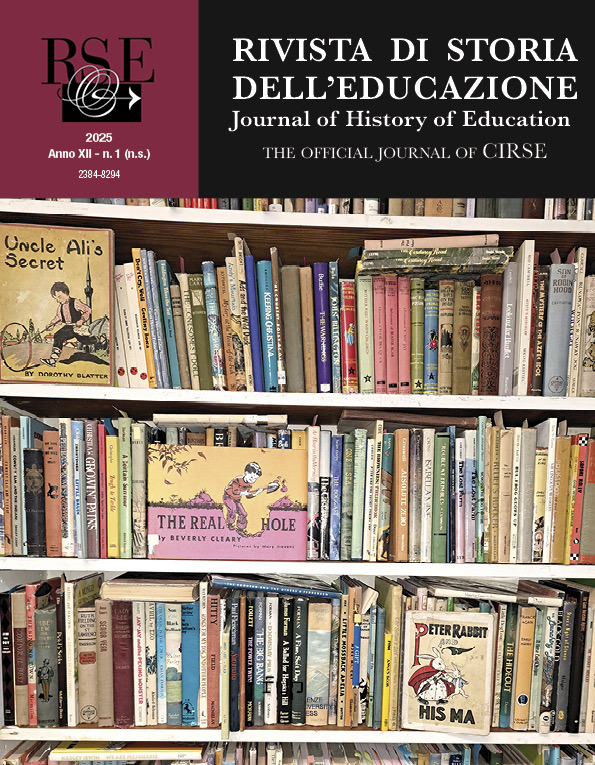Between “Excerpts, Letters and Moveable Findings”. The Magazine Schedario and the Critical Reflection on Children’s Illustration
Published 2025-06-05
Keywords
- educational press,
- illustration,
- publishing industry,
- critical analysis,
- Post-World War II
How to Cite
Copyright (c) 2025 Cristina Gumirato

This work is licensed under a Creative Commons Attribution 4.0 International License.
Abstract
After World War II, various scholars writing in «Schedario» (1953-1998) initiated a debate to redefine the literary field for child readers. This Italian magazine was the first dedicated to a critical reflection on the editorial production for the young, and knew how to become a medium for the main innovations in the field of children’s literature at national and international level, where the reflection concerning illustrations was gaining momentum. From this point of view, the magazine shaped the discourse around illustration in a forward-looking manner. If, on the one hand, it allowed the work of many early Twentieth-century Italian illustrators to make a name for themselves, anticipating and somehow influencing the first more rigorous studies in the field of iconological research for childhood, on the other hand it was able to welcome in-depth studies and news capable of laying the groundwork for new faces in the field of Italian and foreign illustration to find spaces of expression in the coming years. The paper intends to shed light on some of these reflections, to piece together part of the research space in which – as Faeti argues – «there was a struggle to ensure that whatever was left in the background could be salvaged, a dimension which […] allowed to really understand, not to linger on the surface, or to leave anything in the shadow» (Faeti 2010), defining the magazine as a privileged space for investigation of children’s and young people’s illustration as well. The work of filing and analysing the content published between 1953 and 1970 aims to voice the first critical reflections concerning the relationship between text and images in books, highlighting the evolutionary stages of the discipline, but above all re-evaluating the work of one of the most important magazines of the second half of the Twentieth century in Italy in the field of children’s literature.
References
- Bartolozzi Guaspari, Maria. 1954. “Carlo Collodi, Il Giornale dei Bambini e Pinocchio illustrato.” Schedario 4-5-6: 7-12.
- Bernardini, Piero. 1960. “Un figurinaio alla mostra dei cento anni di letteratura giovanile.” Schedario 47: 91.
- Casu, Anna. 1967. “B.I.R. La prima mostra biennale della illustrazione per ragazzi.” Schedario 88: 17-21.
- Centro Didattico Nazionale. 1955. “Notiziario italiano. Mostra di illustratori per ragazzi.” Schedario 11: 45.
- Draghi, Laura. 1955. “Primi incontri coi libri.” Schedario 15: 4-13.
- Draghi, Laura. 1958. “I segreti di Père Castor.” Schedario 33: 1-11
- Ferretti, Annamaria. 1959. “I signori Mumin.” Schedario 42: 62-64.
- Fontana, Ugo, e Donatella Ziliotto. 1955. “Appunti per la realizzazione di albi per bambini di età inferiore ai sei anni.” Schedario 15: 19-23.
- Melegari, Vezio. 1956. “Fasti e problemi dell’illustrazione didascalica.” Schedario 18: 13-25.
- Melegari, Vezio. 1957. “Galleria degli illustratori. Grazia Nidasio.” Schedario 29: 85-87.
- Melegari, Vezio. 1958. “Condizioni e prospettive dell’illustrazione per ragazzi in Italia.” Schedario 35: 8-19.
- Andersen, Hans Christian. 2019. Fiabe e storie. Tradotto da Bruno Berni. Roma: Donzelli.
- Antonio Faeti, Anna Gentilini, Cristina Lastrego, Paola Pallottino e Francesco Testa, 1979. Conformismo e contestazione nel libro per ragazzi. Storia e sperimentazione. Bologna: Cappelli.
- Benjamin, Walter. 2020. Orbis pictus. Scritti sulla letteratura infantile. Tradotto da Giulio Schiavoni. Macerata: Giometti&Antonello.
- Boero, Pino. 2011. “I favolosi anni Settanta. Fantasia e impegno nella letteratura per l’infanzia.” Transalpina 14: 117-30. DOI: https://doi.org/10.4000/transalpina.2418
- Faeti, Antonio. 1972. Guardare le figure. Torino: Einaudi.
- Faeti, Antonio. 2010. “Il tassista aveva capito tutto.” In Dal Museo Nazionale della Scuola all’INDIRE. Storia di un istituto al servizio della scuola italiana (1929-2009), a cura di Pamela Giorgi, 80-81. Firenze: Giunti.
- Farné, Roberto. 2019. Abbecedari e figurine. Educare con le immagini da Comenio ai Pokémon. Bologna: Marietti.
- Fava, Sabrina. 2004. Percorsi critici di letteratura per l’infanzia tra le due guerre. Milano: Vita e Pensiero.
- Giorgi, Pamela. 2010. Dal Museo Nazionale della Scuola all’INDIRE. Storia di un istituto al servizio della scuola italiana (1929-2009). Firenze: Giunti.
- Greppi, Carlo. 2024. Storie che non fanno la Storia. Roma: Editori Laterza.
- Grilli, Giorgia, e Fabian Negrin. 2014. Ugo Fontana. Illustrare per l’infanzia. Pisa: Edizioni ETS.
- Jansson, Tove. 1959. Magia d’estate. Firenze: Vallecchi.
- Krauss, Ruth. 1954. I’ll Be You and You Be Me. New York: Harper & Brothers.
- Krauss, Ruth, e Sendak Maurice. 2025. Io ero te e tu eri me. Tradotto da Sergio Ruzzier. Milano: Adelphi.
- Lepri, Chiara. 2016. Le immagini raccontano. L’iconografia nella formazione dell’immaginario infantile. Pisa: Edizioni ETS.
- Lollo, Renata. 2003. Sulla letteratura per l’infanzia. Brescia: La Scuola.
- Meda, Juri. 2018. “Dal Museo Didattico Nazionale al Museo Nazionale della Scuola di Firenze (1929-1941)”, in La práctica educativa. Historia, memoria y patrimonio, a cura di Sara González, Juri Meda, Xavier Motilla e Luigiaurelio Pomante, 925-38. Salamanca: FahrenHouse.
- Negri, Martino. 2020. “Non solo Emme. Antiautoritarismo e utopia negli albi illustrati in Italia dopo il ’68”, in Autorità in crisi. Scuola, famiglia, società prima e dopo il ‘68, a cura di Tiziana Pironi, 273-281. Roma: Aracne.
- Pallottino, Paola. 1979. L’asso degli illustratori. Piero Bernardini. Bologna: Cappelli.
- Pallottino, Paola. 1988. Storia dell’illustrazione italiana. Libri e periodici a figure dal XV al XX secolo. Bologna: Zanichelli.
- Pallottino, Paola. 2019. Le figure per dirlo. Storia delle illustratrici italiane. Roma: Treccani.

